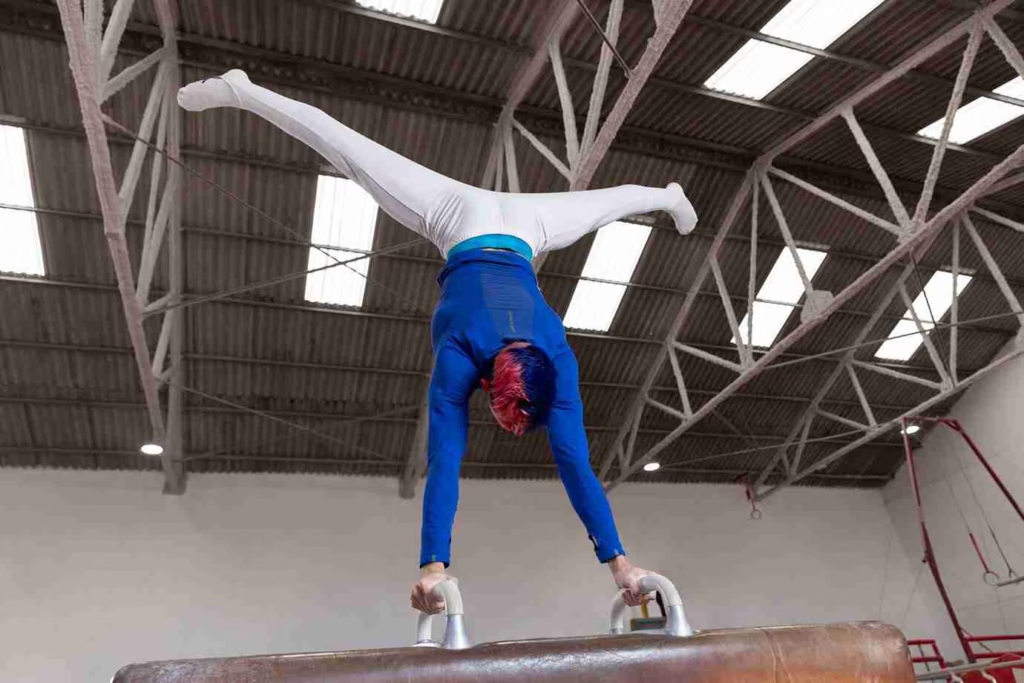Gymnastics is not athletic—gymnastics is a more esthetic sport that took partially from power nakedness, cultivating beauty, and nature’s flexibility. A gymnastics exercise, as opposed to typical exercises in the gymnasium, requires functional strength, stable joints, and kinesthetic feel so that one will be capable enough to become skilled at feats such as handstands, flipping, and balance. Whether you’re an experienced or new gymnast, a productive training regimen for gymnastics must be used in order to prevent injury, develop foundation skills, and advance effectively and safely. The Ultimate Workout Routine for Gymnastics can assist you in obtaining the athleticism you need to perform successfully in this high-intensity sport, as we take you through an evidence-informed process of strength acquisition, flexibility, and skill acquisition.
Three Legs of Gymnastics Training
Three pillars of a successful gymnastics exercise program are strength, flexibility, and learning skills.
-
Strength:
There is some explosive power needed for vaulting and ring and static hold (e.g., planche).
-
Flexibility:
Backbending and shoulder circles are involved in splits and jumping and dismounting.
-
Skill Mastery:
Confidence and muscle memory are developed through drilling (cartwheel, handstand walk, etc.).
Until each of the above are in alignment, plateaus or injury will occur for athletes. For example, tight hips will limit split leaps and poor shoulders will mean no successful handstands. All three pillars are present in this one exercise.
Equipment Needed in Your Gymnastics Training Routine
You don’t require the entire gym to start. The following is a cost-effective toolkit:
- Parallettes:For conditioning in handstand and L-sit (utilize PVC pipes as the DIY option).
- Resistance Bands: Stretching and enabling stretches such as oversplits.
- Floor Mats:Cushions the joint of the tumbling training.
- Balance Beams: Replacement for low, hard bench to utilize at home.
Low-priced equipment, such as dip chair or wall to set up a handstand, is so low-priced that one can easily manage this gymnastics workout routine.
The Entire Gymnastics Workout Routine Breakdown
-
Dynamic Warm-Up (10–15 minutes)
Start with a brief cardiovascular (jogging or jumping rope) warm-up and then dynamic stretching such as leg swings, twists, and arm circles. This section conditions the muscle for explosive movement and also for injury prevention.
-
Building Strength Phase (30–40 minutes)
- Upper Body:8–10 reps of 3 sets of push-ups pseudo planche and pull-ups condition shoulders, chest, and triceps.
- Core:3 sets of 30 seconds hollow body holds and dragon flags condition stability to allow air skills.
- Lower Body:Pistol squats (3 sets of 5–8 per leg) condition single-leg power for vaulting and jumping.
-
Flexibility & Mobility Drills (20–30 Minutes)
Active stretches such as straddle reaches and bridge push-ups are prioritized higher. PNF stretching is applied in splits: contract hamstrings for 10 seconds and release deeper into the stretch.
-
Skill-Specific Training (20–30 minutes)
- Beginners:Cartwheels, forward rolls.
- Advanced Players: Muscle-ups on rings, round-offs, or back handsprings.
Master good form at all times, even slow—tape yourself and correct faults like arched backs on handstands.
-
Cool-Down & Recovery (10–15 minutes)
Finish with static stretching (e.g., butterfly stance for hip), foam roll relaxed contracted muscles. Refuel and rehydrate within 30 minutes with a protein snack.
Sample Weekly Training Schedule
Don’t overtrain by following this immaculately balanced routine:
- Day 1:Strength (upper body + core) + Handstand skill practice.
- Day 2: Flexibility (splits, backbends) + Light cardio (jumping jacks).
- Day 3:Active recovery (yoga or swimming).
- Day 4: Strength (lower body + core) + Tumbling.
- Day 5: Mobility (shoulders, wrists) + Balance beam.
- Day 6: Full routine simulation (incorporate strength, skills, and flexibility).
- Day 7: Rest
Customize to your needs—advanced can include extra skill days, and beginners can reduce intensity.
Nutrition: Energy Food for Your Gymnastics Performance
Gymnasts burn 500–800 calories during training. Tip:
- Pre-Training: Oatmeal and berry (carbohydrate as energy) or banana and almond butter.
- Post-Training: Granola and Greek yogurt (carbohydrate + protein to re-fuel).
- Hydration: Electrolyte water with extended training to prevent cramping.
Loosen up by not consuming big meals 2 hours prior to training.
Common Mistakes to Avoid
-
Wrist Warm-Ups Neglected:
Tissue-paper wrists = achy wrists on handstands. Brawny wrists by performing wrist curls.
-
Overtraining:
Slouching = tired. High-impact drill train 4 times a week.
-
Mobility Neglected:
Aching shoulders? Stretch for 10 minutes every day at the door.
World-Class Gymnast Secrets
- Simone Biles’ Skill:“Break skills into smaller progressions. Master fundamentals before progressing.”
- Coach’s Secret: “Mental visualization—picture your routine before performing it.”
- Recovery Hack: Ice baths reduce swelling after intense training sessions.
Conclusion
It takes time to master gymnastics, but now you have the master plan with this gym workout plan for gymnastics. Monitor progress with journal or photos and celebrate small successes—handstand for 10 seconds or first backbend.
Frequently Asked Questions (FAQs)
Too old to start gymnastics routine as an adult?
Yes! Start with fundamentals of strength and flexibility. Progress to level of difficulty gradually to avoid overstraining.
How long before results are seen?
Strength in 4–6 weeks; flexibility and skills in 3–6 months of regular practice.
Will weight be lost through gymnastics training?
Yes—burn calories and lean muscle.

